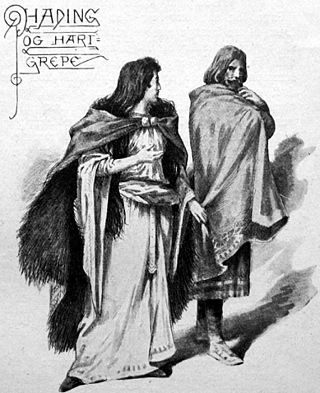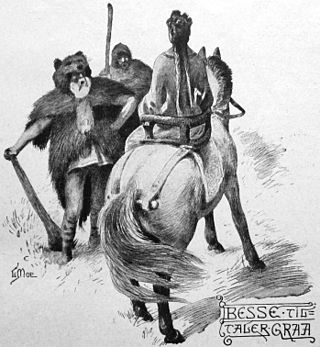
Gesta Danorum is a patriotic work of Danish history, by the 12th-century author Saxo Grammaticus. It is the most ambitious literary undertaking of medieval Denmark and is an essential source for the nation's early history. It is also one of the oldest known written documents about the history of Estonia and Latvia.

Allen Kelsey Grammer is an American actor. He gained fame for his role as psychiatrist Dr. Frasier Crane on the NBC sitcom Cheers (1984–1993) and its spin-off Frasier. At more than 20 years on-air, this is one of the longest-running roles played by a single live-action actor in television history. He has received numerous accolades including a total of six Emmy Awards, three Golden Globe Awards, a Screen Actors Guild Award, and a Tony Award. He was awarded a star on the Hollywood Walk of Fame in 2000.

Harthacnut, traditionally Hardicanute, sometimes referred to as Canute III, was King of Denmark from 1035 to 1042 and King of the English from 1040 to 1042.

Hans Christian Joachim Gram was a Danish bacteriologist noted for his development of the Gram stain, still a standard technique to classify bacteria and make them more visible under a microscope.

Christian IX was King of Denmark from 15 November 1863 until his death in 1906. From 1863 to 1864, he was concurrently Duke of Schleswig, Holstein and Lauenburg.

Frederick VII was King of Denmark from 1848 to 1863. He was the last Danish monarch of the older Royal branch of the House of Oldenburg and the last king of Denmark to rule as an absolute monarch. During his reign, he signed a constitution that established a Danish parliament and made the country a constitutional monarchy. Frederick's motto was Folkets Kærlighed, min Styrke.
A prince consort is the husband of a monarch who is not a monarch in his own right. In recognition of his status, a prince consort may be given a formal title, such as prince. Most monarchies do not allow the husband of a queen regnant to be titled as a king because it is perceived as a higher title than queen, however, some monarchies use the title of king consort for the role.

Christian VI was King of Denmark and Norway from 1730 to 1746. The eldest surviving son of Frederick IV and Louise of Mecklenburg-Güstrow, he is considered one of Denmark-Norway's more anonymous kings, but he was a skilled politician, best known for his authoritarian regime. He was the first king of the Oldenburg dynasty to refrain from entering in any war. During his reign both compulsory confirmation (1736) and a public, nationwide school system (1739) were introduced. His chosen motto was "Deo et populo".

Frederick V was King of Denmark and Norway and Duke of Schleswig-Holstein from 6 August 1746 until his death in 1766. A member of the House of Oldenburg, he was the son of Christian VI of Denmark and Sophie Magdalene of Brandenburg-Kulmbach.

Dr. Frasier Winslow Crane is a fictional character who is both a supporting character on the American television sitcom Cheers and the titular protagonist of its spin-off Frasier and the latter’s 2023 sequel. In all three series, he is portrayed by Kelsey Grammer. The character debuted in the Cheers third-season premiere, "Rebound " (1984), as Diane Chambers's love interest, part of the Sam and Diane story arc. Intended to appear for only a few episodes, Grammer's performance in the role was praised by producers, prompting them to expand his role and increase his prominence. Later in Cheers, Frasier marries Lilith Sternin and has a son, Frederick. After Cheers ended, the character moved to a spin-off series, Frasier, through which the span of his overall television appearances totals 20 years. In the spin-off, Frasier moves back to his birthplace, Seattle, after his divorce from Lilith, who retained custody of Frederick in Boston, and is reunited with a newly created family: his estranged father, Martin, and brother, Niles.

Sigrid the Haughty, also known as Sigrid Storråda (Swedish), is a Scandinavian queen appearing in Norse sagas. Sigrid is named in several late and sometimes contradictory Icelandic sagas composed generations after the events they describe, but there is no reliable historical evidence correlating to her story as they describe her. She is reported by Heimskringla to have been wife of Eric the Victorious of Sweden, sought as wife by Olaf Tryggvasson, then married to Sweyn Forkbeard of Denmark, but elsewhere author Snorri Sturluson says that Sweyn was married to a different woman.

Jørgen Pedersen Gram was a Danish actuary and mathematician who was born in Nustrup, Duchy of Schleswig, Denmark and died in Copenhagen, Denmark.
The Scyldings or Skjǫldungs, both meaning "descendants of Scyld/Skjǫldr", were, according to legends, a clan or dynasty of Danish kings, that in its time conquered and ruled Denmark and Sweden together with part of England, Ireland and North Germany. The name is explained in many texts, such as Friedrich Christoph Dahlmann's 'Research on the Field of History', by the descent of this family from an eponymous king Scyld, but the title is sometimes applied to rulers who purportedly reigned before him, and the supposed king may be an invention to explain the name. There was once a Norse saga on the dynasty, the Skjöldunga saga, but it survives only in a Latin summary by Arngrímur Jónsson.

Hadingus was one of the earliest legendary Danish kings according to Saxo Grammaticus' Gesta Danorum, where he has a detailed biography. Georges Dumézil and others have argued that Hadingus was partially modelled on the god Njörðr.

Ingeborg of Denmark was Queen of France by marriage to Philip II of France. She was a daughter of Valdemar I of Denmark and Sofia of Minsk.
Henrik Ruben Genz is a Danish film director.

Sumble, Sumbli or Sumblus was a legendary king of the Finns during the 1st century. According to Gesta Danorum, Gram, the king of the Danes invaded his realm, but halted after noticing Sumble's daughter, Signe and proposed to her. This enraged Gram's brother-in-law, the king of Norwegians, thus Gram was forced to leave Finland in order to defeat him. However, while he was away, Sumble arranged a marriage between Signe and Henry, the king of the Saxons. Nonetheless, this plan was foiled when Gram murdered Henry during the wedding feast for Signe had informed him.

Signe was a legendary Finnish princess mentioned in Gesta Danorum. The realm of her father, Sumble was invaded by the Danish king, Gram of Denmark, but after noticing her, Gram halted the invasion and proposed to her. Before the marriage could be arranged, Gram had to go to Sweden, while he was away her father plotted to marry her off to a Saxon king, Henry. Signe, unhappy with his arrangement, informed Gram, causing Gram to murder Henry during their wedding.

Bess or Bessus was a legendary Danish general mentioned in Gesta Danorum. His master, Prince Gram gave his wife to him after he grew tired of her. Later Bess served as the principal general of Gram during his invasion of Sweden and led the negotiations with the future wife of Gram, Groa. After Gram married Groa, Bess urged the continuation of war, which eventually led to the death of the Swedish king.

Carl Adolph von Plessen was a Danish statesman and landowner. He played a central role during the early reign of Christian VI but fell out of favour at the court and resigned in 1733. He was a major stakeholder in the Danish Asia Company and the Danish West Indies Company and owned a number of estates in Denmark and the Danish West Indies.
















